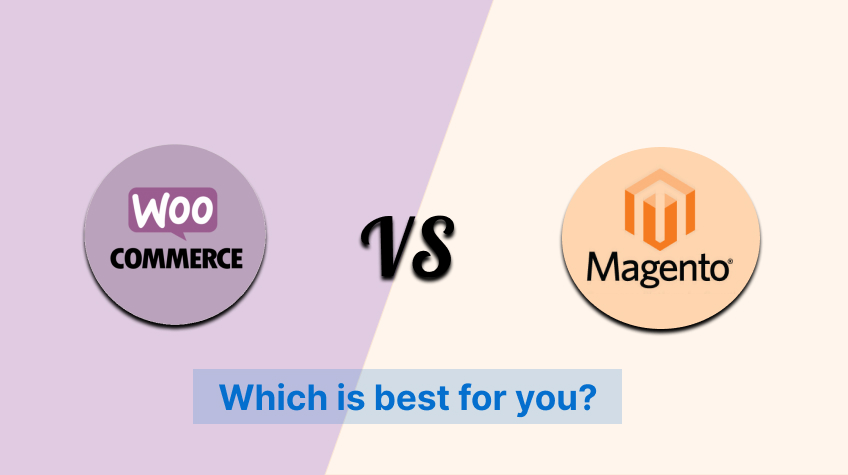
Hello ecommerce enthusiasts!
We have an interesting topic to discuss two of today’s leading e-commerce platforms –WooCommerce vs Magento (Adobe Commerce). We will discuss the right platform and related information, such as tips, tricks, and tools to help you in your business.
It’s good to research about the ecommerce platforms available. It helps you make informed decisions and impact everything from your customer’s perspective, ease of use, and manage your inventory.
It affects your website’s appearance and performance, security, and scalability, which can directly influence your brand reputation and growth potential.
In our quest to help you make an informed decision, we will delve into WooCommerce and Magento, both highly popular in e-commerce. WooCommerce, known for its seamless integration with WordPress and Magento, and praised for its robustness and scalability, offers unique strengths.
Stay with us as we unpack these platforms, evaluating their pros, cons, and best-fit scenarios for businesses.
What is WooCommerce?
WooCommerce is an open-source e-commerce platform that was born in 2011 by a multinational developer group called WooThemes.
Following its 2015 acquisition by Automatic, the company behind WordPress, WooCommerce has grown exponentially, establishing itself as the first choice for online business owners worldwide
WooCommerce brings a suite of essential features to the table. It permits the sale of tangible and digital products, offers robust customization options, and allows integration with numerous payment gateways and third-party services.
Moreover, it provides comprehensive shipping configurations, tax controls, and an efficient inventory management system. Its deep integration with WordPress amplifies its appeal, offering a harmonious solution for those already utilizing this CMS platform.
Predominantly, small to medium-sized enterprises find substantial value in WooCommerce. It offers a straightforward, cost-effective solution to launch an online store. Its intuitive interface and extensive customizability make it an attractive choice for startups and businesses that wish to maintain autonomy over their digital storefront. Additionally, its scalability, facilitated through many available extensions and plugins, accommodates the evolving requirements of growing businesses.
Nonetheless, WooCommerce comes with its own set of strengths and weaknesses. Its merits include user-friendliness, extensive customizability, and a vast, supportive user community.
However, the fact that it operates exclusively with WordPress might deter non-WordPress users. Also, while the fundamental setup is quite straightforward, further customization and scaling could necessitate a degree of technical know-how. As a self-hosted platform, the onus of site security, updates, and backups rests squarely on the site owner.
In conclusion, WooCommerce is a flexible and scalable platform that caters to businesses across various growth stages and with diverse technical capabilities, emphasizing those already aligned with or intending to utilize the WordPress ecosystem.
What is Magento?
Magento is another powerful & open-source platform launched in 2007 by a private tech company called Varien. From a very early age, Magento became known for its industrial-level capabilities.
However, it was improved even more when Adobe acquired it in 2018 and upgraded its features and capabilities to make it best for large e-commerce solutions.
Magento is renowned for its powerful and comprehensive feature set. It can handle multiple stores from a single backend, supports numerous languages and currencies, and offers an advanced search engine optimization (SEO) toolkit.
In addition, Magento presents an extensive range of customizability options, a built-in upselling and cross-selling functionality, and a mobile-friendly configuration. Furthermore, it provides efficient inventory management and various extensions and themes, bolstering its utility.
The primary beneficiaries of Magento are medium to large-scale businesses with high sales volumes and extensive product ranges. Given its high flexibility, scalability, and advanced features, Magento is particularly suited to companies with specific and complex requirements beyond the scope of simpler platforms.
While it demands a higher level of technical expertise, its capabilities make it a powerful tool for e-commerce businesses aiming for extensive growth.
Like any platform, Magento has its advantages and disadvantages. Plus, it offers remarkable scalability, many features, and unrivaled flexibility. Its commitment to e-commerce is reflected in its strong, in-house capabilities.
However, these advantages come with a steep learning curve and higher development and maintenance costs as compared to other platforms.
It’s resource-intensive, which means hosting can be expensive, and you’ll need the right server to get the most out of it. Additionally, although Magento’s community is supportive, support can sometimes be time-consuming.
In essence, Magento is a comprehensive and scalable solution, particularly advantageous for larger businesses with a substantial product catalog and the technical resources to leverage its wide-ranging capabilities.
WooCommerce vs Magento (Adobe Commerce): A feature-by-feature Comparison
There are various things to consider when choosing an e-commerce platform. you have to cover many things in this step of starting your own online business.
Here’s how WooCommerce and Magento stack up against each other
A. Customizability
Both WooCommerce and Magento shine in terms of customizability. WooCommerce, with its plethora of plugins such as WooCommerce video product gallery and themes, allows businesses to craft a unique online store. On the other hand, Magento is renowned for its advanced customization options, allowing for more complex and specific tailoring. However, such advanced customizations in Magento often require more technical expertise.
B. Scalability
Magento is often favored for its impressive scalability, easy handling of large product catalogs, and high traffic volumes, an essential feature for large-scale enterprises. WooCommerce, though starting from a more basic standpoint, can also be scaled effectively with various extensions, proving adequate for small to medium-sized businesses.
C. Security
Security is paramount in e-commerce, and both platforms take this seriously. WooCommerce relies on WordPress security measures and additional plugins for enhanced protection. Magento offers robust, built-in security features and releases frequent security patches. Nonetheless, the responsibility of maintaining security largely falls on the store owner in both cases.
D. Performance and Speed
Website performance can significantly impact user experience and SEO rankings. Magento, being resource-intensive, requires a robust server infrastructure to function optimally. WooCommerce, lighter by nature, often results in faster loading times but can be slowed with many plugins or large traffic volumes.
E. Ease of Use
WooCommerce takes the crown in terms of ease of use, with its user-friendly interface, especially for those already familiar with WordPress. While a strength for customizability and scalability, Magento’s complexity also means a steeper learning curve.
F. SEO Capabilities
Both platforms offer comprehensive SEO tools. Magento comes with advanced SEO features out of the box. WooCommerce, through WordPress, is naturally SEO-friendly and can be further enhanced with additional SEO plugins.
G. Support and Community
Both platforms boast a large community of developers and users. WooCommerce benefits from the extensive WordPress community and Magento has a dedicated, though smaller, community. Premium support is available at additional costs for both.
H. Pricing
WooCommerce stands out for its cost-effectiveness. The plugin is free, and costs are primarily for hosting, theme, and extensions. Magento offers a free Community version, but its Enterprise edition can be costly. Moreover, due to its technical nature, businesses may incur additional expenses for professional Magento developers.
In conclusion, choosing between WooCommerce and Magento largely depends on your business size, technical capability, and specific needs. Both platforms have strengths in different areas, and your unique requirements will dictate the best fit for your e-commerce venture.
Final Thoughts
Choosing between WooCommerce and Magento is much like selecting the right tool for a specific task, depending on your business size, goals, and resources. If you’re a small to medium-sized business dipping your toes into e-commerce, WooCommerce might be your best bet. Its friendly interface, cost-effectiveness, and deep integration with WordPress can be a real boon.
If you’re a larger entity with a broad product range and have technical resources, Magento’s scalability and robust features can drive your growth plans.
In the end, it’s about choosing a platform that resonates not only with your current status but also with future aspirations.






